This site uses only a few technical cookies necessary for its operation. By continuing to browse, you accept their use.
To find out more...
To find out more...
A little sugar anyway
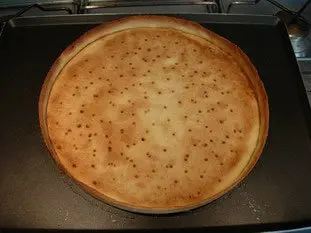
I'm coming back to something I've already told you about, but which focused on brioche dough, so I'll try to generalize about these doughs, which are generally sweet, but can also be used in savory recipes.
7,217 5/5 (15 reviews)
Keywords for this post:SugarDoughColoringBakingGoldenLast modified on: November 14th 2020
A little sugar anyway
If you're making a tart or a tartelette, you're almost certainly going to use shortcrust pastry. For a dessert, it's very classic (and delicious), but what about for something savory: a quiche or a tourte, for example?
In that case, you'd be better off using a much less sweet shortcrust pastry to line your mold(s).
Less sweet (20 g vs. 110 g for 500 g flour), but still sweet, wouldn't it be worth doing away with sugar altogether?
The small amount of sugar won't affect the taste (so your quiche won't be sweet, phew), but it will affect the coloring of the pastry, bringing about a beautiful browning at the end of cooking. This browning is due to the caramelization of the sugar during cooking, the famous Maillard reaction.
Put another way, if you don't put that little bit of sugar in, your tart/quiche/tart, or rather its pastry, will remain a little whitish, dull, and therefore sadly unappetizing.
This small amount of sugar (5% of the weight of flour), which you can't taste, but which affects the coloring, is found in almost all doughs that you want to be golden-brown: shortcrust, deep-drawn, pizza, nacho, etc., and you shouldn't eliminate it thinking it's useless.
To sum up: you always need a little sugar in a flour-based dough intended for a savoury recipe, for the sake of beautiful colouring when cooked.
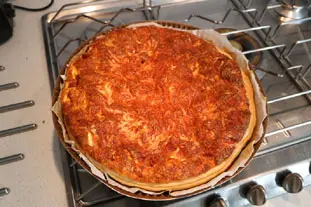
In that case, you'd be better off using a much less sweet shortcrust pastry to line your mold(s).
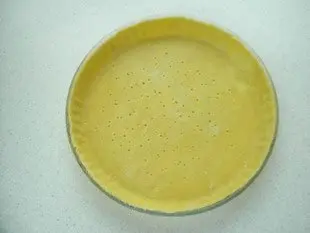
Less sweet (20 g vs. 110 g for 500 g flour), but still sweet, wouldn't it be worth doing away with sugar altogether?
The small amount of sugar won't affect the taste (so your quiche won't be sweet, phew), but it will affect the coloring of the pastry, bringing about a beautiful browning at the end of cooking. This browning is due to the caramelization of the sugar during cooking, the famous Maillard reaction.
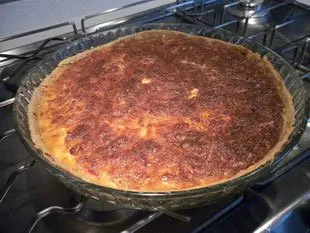
Put another way, if you don't put that little bit of sugar in, your tart/quiche/tart, or rather its pastry, will remain a little whitish, dull, and therefore sadly unappetizing.
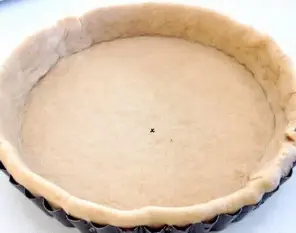
This small amount of sugar (5% of the weight of flour), which you can't taste, but which affects the coloring, is found in almost all doughs that you want to be golden-brown: shortcrust, deep-drawn, pizza, nacho, etc., and you shouldn't eliminate it thinking it's useless.
To sum up: you always need a little sugar in a flour-based dough intended for a savoury recipe, for the sake of beautiful colouring when cooked.
Lasts posts
Butter vs. grease
We often read in a recipe where a pastry is put into a mould that, just before pouring, the mould should be buttered or greased. But what's the difference between these 2 terms?December 1st 20259475
Getting out of the fridge early
Very often when you're cooking, you need to take food or preparations out of the fridge, to use them in the recipe in progress. There's nothing tricky about this: you just take them out of the fridge and use them, usually immediately, in the recipe. But is this really a good method?November 24th 20251,0845
Who's making the croissants?
When you look at a bakery from the outside, you naturally think that in the bakery, the bakers make the bread, and in the laboratory, the pastry chefs make the cakes. It's very often like that, with each of these professions having quite different ways of working, but sometimes there's also one...November 23th 2025981
Oven height
When we put a dish or cake in the oven, we naturally tend to put it on the middle shelf, and that's what we usually do. But in some cases, this position and height can be a little tricky, so let's find out why.October 8th 20252,6745
The importance of sieving
In recipes that use a fine powder (flour, powdered sugar, etc.), you'll often see the advice to sift before using it. To sift is to pass the powder in question through a sieve (a very fine strainer) before incorporating it into your recipe. It's often advice, but is it really useful?September 3rd 20257,4983
Other pages you may also like
Candied fruits: don't get ripped off
Do you like candied fruit? You might like to nibble a handful or add it to a recipe, like a classic fruit cake or delicious Italian specialities like panettone or sicilian epiphany pie.June 21th 201767 K 24.2
The first breads of humanity?
I have already told you in a previous article the beautiful story of the croissants, but do you know what it is about the bread, who "invented" it, where and when? Well, you can imagine that recent discoveries, in 2018, have profoundly changed the history of bread.February 16th 201914 K5
Preserving egg yolks
If you're using only the egg whites in a recipe (such as meringues ), you'll need to store the yolks until you're ready to use them again. There's nothing very complicated about this in principle - all you have to do is chill them, but there are a few pitfalls to be avoided in practice.June 18th 20248,1045
Croutons
Do you use croutons, that typically French trick of toasting small pieces of bread on the side to add to a recipe? They're just delicious, but you need to know 2 or 3 things about them. .December 30th 202010 K5
Sugar syrups
In cooking, and especially in pastry, we often use sugar syrups, a simple mixture of water and sugar in varying proportions. Here is a presentation of their differences. .January 17th 202312 K4.8
Post a comment or question
Follow this page
If you are interested in this page, you can "follow" it, by entering your email address here. You will then receive a notification immediately each time the page is modified or a new comment is added. Please note that you will need to confirm this following.
Note: We'll never share your e-mail address with anyone else.
Alternatively: you can subscribe to the mailing list of cooling-ez.com , you will receive a e-mail for each new recipe published on the site.









